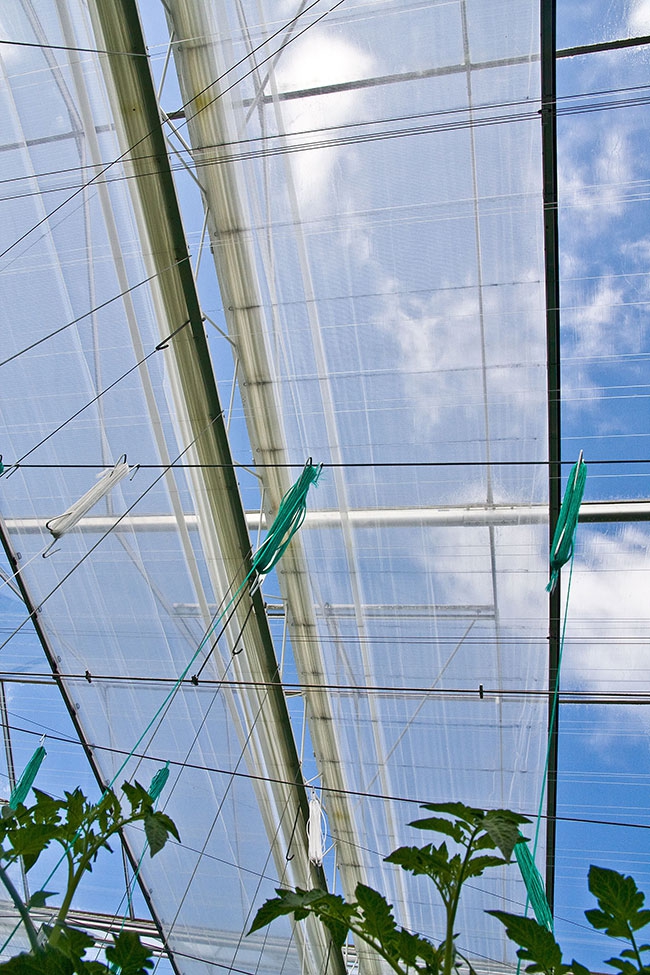
Features
Environmental Control
Structures & Equipment
Climate Control
Time to Consider Double Screening?
March 4, 2015 By Mauricio Manotas

With double screening, you double your ability to heat, cool and light on demand, because with the touch of a button you’re able to expand or retract curtains in any combination to provide the best climate possible for your crop.
Climate is king in the greenhouse world, and proper management of the greenhouse environment presents as many challenges as it does opportunities.
Do you shade at the expense of energy savings? Do you install an energy screen, then still have to whitewash?
Luckily growers, especially vegetable growers, are finding the more versatile practice of double screening gives them ultimate control of their greenhouses. Long a staple in European horticulture, this versatile technology is moving into North America.
FEEDING THE CLIMATE
For greenhouse production, a wide combination of screens is available. Depending on goals, a grower can select the screens that give the optimal climate. When you have a single layer of screens, you end up having to decide which characteristic is most important to you, and then install the screen that offers that benefit.
For example, a clear energy savings screen will help with your utility bills, but will not provide significant shade. An aluminum shade will provide higher energy savings plus shade, but at the expense of light, a particular issue during winter.
Double screening lets you adapt your greenhouse to the time of year and the climate. Think of it as going to the beach: you take 50 SPF and 15 SPF sunscreen, and you apply each at different times depending on the sun position, light level and time of year. Likewise with two greenhouse screens, you have the flexibility of using shade in late spring and summer and an energy savings screen from late September through May.
Leading vegetable growers in Ontario are experiencing the technology’s benefits, but each situation is different. There is no magic bullet that solves all challenges for greenhouse growers. Screen choices depend on many factors and must be carefully analyzed on a case-by-case basis to determine the best solution for each greenhouse.
Solutions will depend on geographic location, climate, crops grown and greenhouse style (glass or plastic). The same screen combination that won’t work in Ontario will work in British Columbia.
Farther south in Ontario close to the U.S. border, where bright sunny days can come with -9C temperatures, we might allow more shade because light levels are higher.
With British Columbia’s lower light levels but more consistent temperatures, that choice might not be optimal.
And in the far northeast, where we see large temperature swings – very cold in the winter and very hot in the summer – that must be factored in as well.
DOUBLE THE BENEFITS
With double screening, you double your ability to heat, cool and light on demand, because with the touch of a button you’re able to expand or retract curtains in any combination to provide the best climate possible for your crop. So if your temperatures and light levels are changing regularly, as today’s weather patterns can in fact produce, you have the ability to respond quickly, rather than equipping your greenhouse to the lowest common denominator and hoping for success.
The goal, of course, is to maintain relatively consistent ambient conditions, and these systems give you more precision in making that reality.
In addition to their climatic benefits, double screening systems provide excellent light reduction properties, reducing emission to as little as 0.1 per cent. This ancillary application, while very effective, will likely be appealing to growers in areas with strict light pollution regulations, such as in large metropolitan areas.
For any of these applications, double curtains can be installed in several different ways, depending on the grower’s preference and the best configuration for maximum benefits in the greenhouse. Curtains may be positioned one behind the other moving in the same direction, or one above the other on the same frame.
So, if you’re limited on space, for example, you could install both on one cable system. However they are installed, the goal is always creating the best climate possible for the entire year.
Mauricio Manotas is president of Ludvig Svensson, Inc. He can be reached at 704-357-0457 or Mauricio.Manotas@ludvigsvensson.com.
Print this page